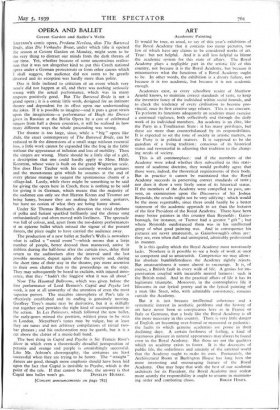ART
Academic Painting
IT would be true, as usual, to say of this year's exhibition of the Royal Academy that it contains too many pictures, too few of which have any claims to be considered works of art. True : but not helpful. And it is still less helpful to blame the academic system for this state of affairs. The Royal Academy plays a negligible part in the artistic life of this country, not because it is the Royal Academy, but because it misconceives what the functions of a Royal Academy ought to be. In other words, the exhibition is a dreary failure, not because it is too academic, but because it is not academic enough.
Academies exist, as every schoolboy reader of Matthew Arnold knows, to maintain correct standards of taste, to keep the inventive fancy of the individual within social bounds, and to check the tendency of every civilisation to become pro- vincial, once its first creative urge relaxes. This is no sinecure. To perform its functions adequately an academy must exercise a continual vigilance, both collectively and through the daily work of its individual members. An academy is an elite, like the Party in a Totalitarian State : it has many privileges, but these are more than counterbalanced by its responsibilities. It is expected to set the tone of society in artistic matters, as the Party is in political matters. It is supposed to be the guardian of a living tradition : conscious of its historical status and resourceful in adjusting that tradition to the chang- ing needs of society.
This is all commonplace : and if the members of the Academy were asked whether they subscribed to this state- ment of academic doctrine, they would probably agree that those were, indeed, the theoretical requirements of their body. But in practice it cannot be maintained that the Royal Academy succeeds in preserving correct standards of taste ; nor does it show a very lively sense of its historical status. If the members of the Academy were compelled to pass, un- seen, an examination upon the Discourses of Sir Joshua Reynolds, the results might not be very edifying : which would be the more regrettable, since there could hardly be a better statement of the academic approach to art than the lectures of the first President of the Royal Academy. There have been many better painters in this country than Reynolds : Gains- borough, for instance, or Turner had a greater " gift " ; but where Reynolds outdistanced them was in his intellectual grasp of what good painting was. And in consequence his pictures are never amateurish, as Gainsborough's often are: they are, even when dull and uninspired, admirably professional in manner.
It is this quality which the Royal Academy most notoriously lacks. Nowhere is it possible to see a body of work at once so competent and so amateurish. Competence we may allow : for absolute bumblefistedness the Academy rightly rejects. But amateurishness it seems almost to encourage. It is, of course, a British fault in every walk of life. A genius for im- provisation coupled with incurable mental laziness : such is the British mind. And in the practical affairs of life it has its legitimate triumphs. Moreover, in the contemplative life it blossoms in our lyrical poetry and in the lyrical painting of a man like Steer, who, with admirable consistency, remains outside the Academy.
But it is just because intellectual coherence and a systematic interest in aesthetic problems and the history of art have never been so conspicuous here as in France or Italy or Germany, that a body like the Royal Academy is all the more necessary in this country. There is very little, danger of English art becoming over-formal or mannered or pedantic : the faults to which genuine academies are prone in their declining days. A certain freshness of feeling, a kind of ingenuous pleasure in natural appearances may always be found even in the Royal Academy. But those are not the qualities which an academy exists to foster. It is the decencies of public life, the orderliness and amenity of the external world that the Academy ought to make its own. Fortunately, the Architectural Room at Burlington House has long been the most interesting and encouraging feature of the Royal Academy. One may hope that with the best of our academic architects for its President, the Royal Academy may realise more acutely the responsibility it ought to assume in maintain-
ing order ama combating chaos. ROGER HINKS.














































 Previous page
Previous page